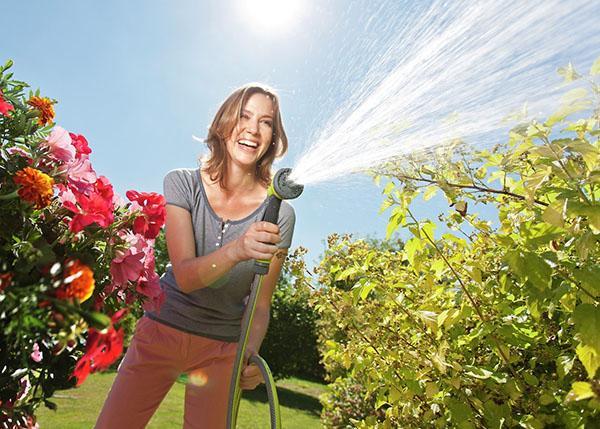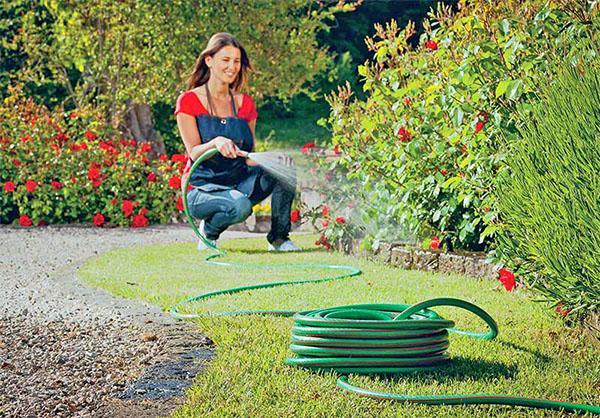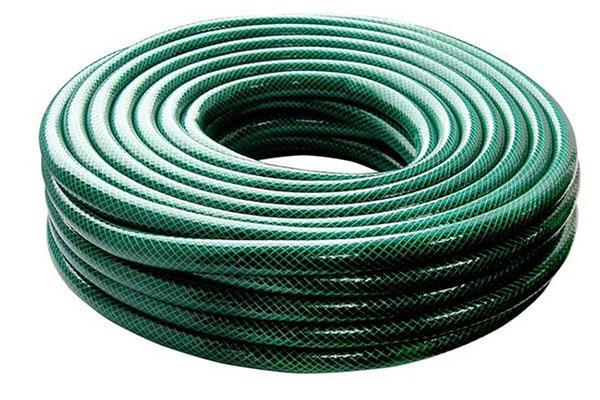How to choose a hose for irrigation at their summer cottage
 When caring for a vegetable garden, orchard and decorative lawns in summer, you cannot do without high-quality regular watering. It is convenient to use a watering hose for this. They come in various types, lengths, diameters. In the selection process, it is necessary to consider all varieties in order to choose the most suitable option.
When caring for a vegetable garden, orchard and decorative lawns in summer, you cannot do without high-quality regular watering. It is convenient to use a watering hose for this. They come in various types, lengths, diameters. In the selection process, it is necessary to consider all varieties in order to choose the most suitable option.
Where to start choosing

An important circumstance that must be taken into account is the water pressure. The load also affects the requirements for the irrigation system.
Main characteristics:
- material of manufacture;
- length;
- section diameter;
- pressure;
- temperature;
- type of execution;
- transparency.
Length: how not to lose
 The irrigation hose can be purchased in a wide range of lengths: from several meters to several tens of meters. The size of an ordinary hose is selected by measuring the distance from the water source, where it will be connected, to the place of irrigation. At the same time, rounding up and a small increase are made.
The irrigation hose can be purchased in a wide range of lengths: from several meters to several tens of meters. The size of an ordinary hose is selected by measuring the distance from the water source, where it will be connected, to the place of irrigation. At the same time, rounding up and a small increase are made.
If a constant movement of the hose is assumed, then the length should be sufficient to any part of the section.
An exception to the length calculation is special purpose systems, for example dripthat fit on the site. For them, a measurement is required taking into account how the hose will run.
Diameter: bigger is not always better
 The garden hose is available in a range of 13 mm (0.5 in.) To 38 mm. The choice is made taking into account the fastening and water pressure. If powerful pump, then you can pay attention to the hoses with a larger diameter. With a low pressure, a smaller diameter should be unambiguously chosen.
The garden hose is available in a range of 13 mm (0.5 in.) To 38 mm. The choice is made taking into account the fastening and water pressure. If powerful pump, then you can pay attention to the hoses with a larger diameter. With a low pressure, a smaller diameter should be unambiguously chosen.
Hoses with a diameter of ½ and ¾ inch are considered optimal for watering.
Water pressure: large or small
 Under what pressure the water flows depends on the pressure. A quality irrigation hose must withstand the pressure in the system. The best indicators for this parameter are given by reinforced models consisting of several layers, the worst - single-layer ones.
Under what pressure the water flows depends on the pressure. A quality irrigation hose must withstand the pressure in the system. The best indicators for this parameter are given by reinforced models consisting of several layers, the worst - single-layer ones.
If the head is insufficient, a pump must be used.
Transparency: what it affects

The hose material can be:
- opaque;
- transparent.
The second option is the least preferable, since under the influence of sunlight and summer heat, green algae can begin to appear in the transparent hose along the inside. It is extremely difficult to clear it. In this regard, it is advisable to choose opaque models.
Temperature indicators: why is resistance to low temperatures needed
 This indicator is also important. It should be borne in mind that the irrigation system is operated in warm and even hot weather, and the hose can be stored in winter in outbuildings with insufficient heating.
This indicator is also important. It should be borne in mind that the irrigation system is operated in warm and even hot weather, and the hose can be stored in winter in outbuildings with insufficient heating.
If the temperature regime of storage and operation goes beyond the permissible, the material may lose its elasticity and strength, and in some cases it will completely become unusable and will require replacement.
How to choose an irrigation hose based on temperature conditions? For the middle band, this is the range from -25 ° C to + 40 ° C.
Execution type: from classic to modern technology

According to the type of execution, hose irrigation systems are divided into several types:
- single-layer;
- multilayer (have increased strength, which depends on the number and composition of layers);
- reinforced (ideal for high pressure and high loads);
- corrugated (resistant to folds, versatile in use);
- spiral (used for spot irrigation, compact and easy to use);
- stretching (most often used for watering flower beds on flat areas, has a two-layer composition).
Irrigation hose: material selection
Irrigation material plays one of the key roles. It determines performance, service life and usability.
Rubber: time-tested

This is a traditional option that has a lot of advantages:
- availability;
- high strength;
- resistance to high water pressure;
- withstanding significant temperature differences without loss of performance;
- elasticity;
- resistance to solar radiation.
Rubber models can have different ductility. In the selection process, it should be borne in mind that the flexible soft garden hose will last longer than the hard one.
The weight of such a hose can create some inconvenience if it needs to be moved from place to place. Rubber models are designed for technical work, irrigation of arable land, but not for drinking water supply. For this, only hoses with a special label are intended, and usually it is a thin rubber hose.
Rubber is used for the production of universal hoses, even for constant irrigation, and with significant temperature changes. The service life is at least 10 years.
PVC: reinforced and single layer options
 Polyvinyl chloride (PVC) is a fairly popular material that is chosen for the production of hoses. Most often these are inexpensive and easy-to-use models. PVC hoses can be single-layer or multi-layer, with additional reinforcement.
Polyvinyl chloride (PVC) is a fairly popular material that is chosen for the production of hoses. Most often these are inexpensive and easy-to-use models. PVC hoses can be single-layer or multi-layer, with additional reinforcement.
What is Reinforced Hose? This is a hose that is provided with additional reinforcement due to multi-layer and sealing with a special insert.
This structure has advantages:
- increased resistance to water pressure and temperature differences;
- the service life is increased.
But even such materials can be prone to deformation. To prevent this from happening, it is important to clarify the type of PVC reinforcement.
Such a multilayer irrigation hose can be reinforced with cruciform and mesh weaving. The preference is given to the net weaving, as the most durable.
Since PVC is not resistant to temperature changes, it is advisable to use a hose made of this material only in the spring-summer period, when the temperature does not drop below -5 ° C. The service life of this inventory is 3 years.
Plastic: there are more disadvantages than advantages
 The outsider in popularity as a material for a hose is plastic. A plastic water hose is impractical, but cheap, lightweight and comes in a wide variety of colors.
The outsider in popularity as a material for a hose is plastic. A plastic water hose is impractical, but cheap, lightweight and comes in a wide variety of colors.
The disadvantages include the following factors:
- no resistance to high pressure (maximum - up to 5 bar);
- can burst at a temperature drop;
- weak elasticity - when bending, cracks may occur in the body;
- the material tends to form limescale inside.
Nylon: what's behind a smart look
 The lightweight material of manufacture contributes to the fact that the hose from it will weigh little, and even a child can cope with its movement around the site. Nylon gives the product not only lightness, but also elasticity and strength - such a hose can be twisted without problems.
The lightweight material of manufacture contributes to the fact that the hose from it will weigh little, and even a child can cope with its movement around the site. Nylon gives the product not only lightness, but also elasticity and strength - such a hose can be twisted without problems.
If we consider the types of irrigation hoses in comparison, then nylon is not very popular due to its negative sides:
- instability to high water pressure;
- poor reaction of the material to temperature changes.
Due to such operating features, the use of such a hose will not be long - a maximum of 2 seasons.
Silicone: when it should not be used
 The silicone watering hose works well at both -20 ° C and + 40 ° C. It is elastic, has an affordable cost, and curls well. Despite the fact that the material may expand slightly under the influence of the sun, this type of hose cannot be used for irrigation with water under pressure. Silicone is selected only when the olive is carried out by gravity.
The silicone watering hose works well at both -20 ° C and + 40 ° C. It is elastic, has an affordable cost, and curls well. Despite the fact that the material may expand slightly under the influence of the sun, this type of hose cannot be used for irrigation with water under pressure. Silicone is selected only when the olive is carried out by gravity.
Silicone models look like PVC, so a natural question arises, how to distinguish a silicone hose from PVC? The difference is that the silicone hose does not bend.
Miracle hose: is there a reason to believe in a miracle

The miracle irrigation hose is one of the achievements of modern technology. In recent years, it has gained popularity due to its good characteristics:
- ease of use;
- compactness (increases in size several times only when connected to a water source);
- you can select the mode of water supply;
- high strength;
- long service life;
- resistance to high water pressure;
- good tolerance to temperature changes.
The compactness of this type of sprinkler is amazing. When filled with water, there is a significant increase in its size, and after the end of irrigation, the material folds itself.
Non-twisting garden hose is manufactured using modern materials with high performance characteristics:
- Polyester woven fabric.
- High quality plastic.
- Latex.
Types of hoses by purpose
There are several types of watering. Depending on the purpose of the irrigation system, the appropriate type of hose is selected. In addition to the usual cast hoses, there are also hoses with holes for irrigation.
Oozing
 This is one type that has holes along its entire length. This structure provides an economical way to water those plants that are especially sensitive to moisture shortages.
This is one type that has holes along its entire length. This structure provides an economical way to water those plants that are especially sensitive to moisture shortages.
Oozing models are made from a two-layer material. In it, the inner part has passages for water, and small holes are located on the outer surface.
Drip
 For watering directly under the root of plants, a drip option is used. This hose has holes along its entire length. It can be left on the site even for several seasons.
For watering directly under the root of plants, a drip option is used. This hose has holes along its entire length. It can be left on the site even for several seasons.
Traditional

Using a hose of the usual (traditional) design, you can water various plants in two ways:
- spraying using a special nozzle;
- under the root.
This type of hose is the most versatile and can be adapted for irrigation of various crops.
Sprinkler
 A shallow spray of water is good for plants that have shallow root systems. The spraying process in this case resembles a very light rain. Water from the place of spraying scatters evenly over several meters, creating a finely dispersed irrigation.
A shallow spray of water is good for plants that have shallow root systems. The spraying process in this case resembles a very light rain. Water from the place of spraying scatters evenly over several meters, creating a finely dispersed irrigation.
Porous
 For plants that are planted in soils with slow moisture saturation, a porous hose design is the best watering option. At the same time, water flows in slowly, allowing the soil to absorb moisture. Also, porous models are suitable for plants growing on steep slopes.
For plants that are planted in soils with slow moisture saturation, a porous hose design is the best watering option. At the same time, water flows in slowly, allowing the soil to absorb moisture. Also, porous models are suitable for plants growing on steep slopes.
What is the best hoses for irrigation is determined for each specific case individually, taking into account all the requirements for the inventory. Multilayer models benefit in many ways over single-layer models. Hoses for special purposes (oozing, miracle hose and others) are also gaining popularity. A rational approach to the choice of model and material will make it easier to work in the garden and will bring satisfaction.